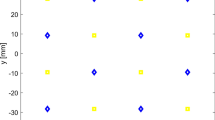Abstract
In this work, new image reconstruction schema has been proposed for back-reflected diffuse optical tomography geometry. 100 source and 100 detector points have been selected as bifurcated probe positions in xy plane. An x, y, and z cubic coordinate grid system has 10 × 10 × 30 mesh grids. In this work, a dynamic mesh grid concept has been introduced first. Each time source and detector positions are changed, x and y coordinate positions have been reassigned automatically. Centers between source and detector positions have been recalculated in xy plane. x and y grid positions have been reassigned around this center points. When using predefined static mesh grid photon fluencies which are coming from Monte Carlo (MC) simulation output or diffusion equation are transferred into static voxels which is only partially correct. Hence there is no symmetry around source–detector matchup center in xy plane and so is not totally correct. In this work, dynamic mesh grids have been created and photon fluencies have been assigned into automatically redefined dynamic mesh grid voxels. One dimensional depth profile has been used for simplicity. Median values of transport functions for each z depth grids have been used. Transport functions of photon fluencies from each source to detector positions have been calculated and each voxel value has been assigned in three dimensional dynamic mesh grid array. We innovated the use of dynamic mesh grid array instead of using static mesh grids which were being used previously, and now have assigned the photon fluencies into the dynamic mesh grid voxels. This also gave us an opportunity to use different transport functions for one dimensional image reconstruction schema. Before, we were using the sum of transport weight functions which are derived from each of the z depth layers. Now we have opportunity to use mean or median values also. Thus we are centering the dynamic mesh grid array by finding the center of each source and detector position successfully. This work gave us encouragement to build tomography devices.







Similar content being viewed by others
References
Kazanci, H.O.: Weight matrix analysis for back reflection continuous wave diffuse optical tomography (CWDOT) systems: translational method. Opt. Quantum Electron. 47(12), 3847–3853 (2015a)
Kazanci, H.O.: Designing intact clinical head laser tomography system. In: Proceedings of IEEE Medical Technologies National Conference (TIPTEKNO). 2015 October 15–18; Bodrum, Mugla, Turkey. IEEE, pp. 280–283, 36720, (2015b). https://doi.org/10.1109/tiptekno.2015.7374104
Kazanci, H.O.: Development of coordinate definition algorithm for head laser tomography system. In: Proceedings of IEEE Medical Technologies National Conference (TIPTEKNO). 2015 October 15–18; Bodrum, Mugla, Turkey. IEEE, pp. 276–279, 36720, (2015c). https://doi.org/10.1109/tiptekno.2015.7374104
Kazanci, H.O.: Non-contact head laser tomography. Opt. Quantum Electron. 48, 330 (2016a). https://doi.org/10.1007/s11082-016-0603-1
Kazanci, H.O.: Head model weight functions generation for laser tomography. Opt. Quantum Electron. 48, 248 (2016b). https://doi.org/10.1007/s11082-016-0526-x
Kazanci, H.O.: Forward model for cranial laser tomography system. Opt. Quantum Electron. 48, 39 (2016c). https://doi.org/10.1007/s11082-016-0664-1
Kazanci, H.O.: Image reconstruction for head laser tomography system—Kafa Lazer Tomografi Sistemi İçin Görüntü Oluşturma Algoritması. Ibni Sina J. Med. Sci. İbni Sina Tıp Bilimleri Dergisi 2(4), 51–55 (2016d)
Kazanci, H.O., Canpolat, M.: Mathematical method for diffuse optical tomography imaging: a research study. El-Cezerî J. Sci. Eng. 1(3), 40–48 (2014)
Kazanci, H.O., Canpolat, M.: Depth normalization algorithm for continuous wave reflectance diffuse optical tomography system. El-Cezerî J. Sci. Eng. 2(1), 40–46 (2015a)
Kazanci, H.O., Canpolat, M.: Continuous wave diffuse optical tomography system with high resolution current to voltage analog digital converter. El-Cezerî J. Sci. Eng. 2(1), 68–77 (2015b)
Kazanci, H.O., Jacques, S.L.: Diffuse light tomography to detect blood vessels using Tikhonov regularization. In: Proceedings of SPIE—Saratov Fall Meetings SFM’15, Optical Technologies in Biophysics and Medicine XVIII; 2015 September 21–25, Saratov State University, Saratov, Russia, (2015)
Kazanci, H.O., Oduncuoglu, M.: Analysis of lung tissue by laser tomography. El Cezeri J. Sci. Eng. 2(3), 75–81 (2015)
Kazanci, H.O., Oduncuoglu, M.: Design of electronic data acquisiton unit for laser tomography system. El-Cezerî J. Sci. Eng. 3(4), 1–10 (2016)
Kazanci, H.O., Mercan, T., Canpolat, M.: Design and evaluation of a reflectance diffuse optical tomography system. Opt. Quantum Electron. 47(2), 257–265 (2015)
Author information
Authors and Affiliations
Corresponding author
Ethics declarations
Conflict of interest
The author declares that he has no competing interests.
Rights and permissions
About this article
Cite this article
Kazanci, H.O. Dynamic mesh grids for laser head tomography. Opt Quant Electron 50, 117 (2018). https://doi.org/10.1007/s11082-018-1387-2
Received:
Accepted:
Published:
DOI: https://doi.org/10.1007/s11082-018-1387-2




